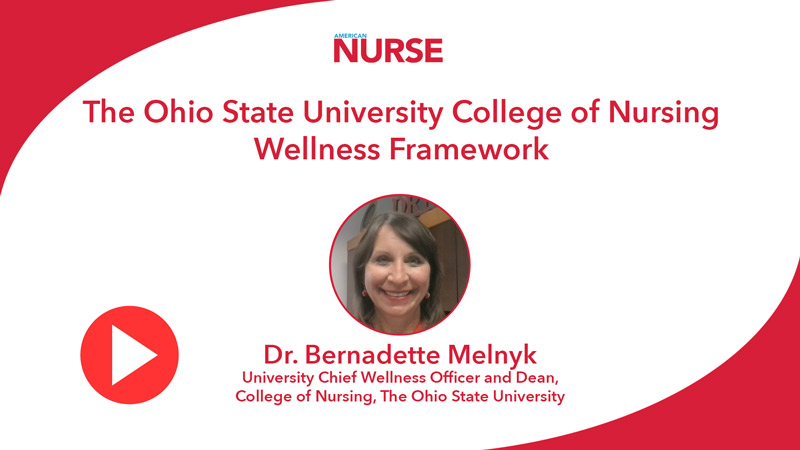The effects of the COVID-19 pandemic of nurses and healthcare workers have been discussed, speculated, and bemoaned at length. But one study has finally placed values and extents to the damage done.
A new study from The Ohio State University College of Nursing highlights the findings of a survey of travel nurses at hospitals and healthcare systems across the country associated with Trusted Health between August and October 2020.
American Nurse talked with Bernadette Melnyk, PhD, RN, CRNP, FAANP, FNAP, FAAN, University Chief Wellness Officer and Dean of the College of Nursing at The Ohio State University (OSU), about the findings from the study – as well as the measures Ohio State has in place to protect its professionals from physical and mental health pitfalls.
Statistics
OSU surveyed over 260 nurses across the country – primarily travel nurses who worked on the front lines during the COVID-19 pandemic. Some key numbers from the study:
On a 10-point scale, a majority of nurses reported physical health (74.6%) and mental health (80.7%) at a five or lower. Additionally:
• 53.8% reported that the pandemic made their physical health worse.
• 79.2% reported that the pandemic made their mental health worse.
“About 30 percent were suffering from depressive symptoms,” said Dr. Melnyk, “and another 37 percent suffering from anxiety.”
65 percent reported feeling ‘burned out’ to some degree.
Shift length played a factor as well, as those who were working 12-hour shifts showed poor physical and mental health outcomes. “We must stop 12-hour shifts,” Dr. Melnyk insisted. “We have so much evidence now showing the longer the shift work, the poorer the health of the nurses.”
What’s more, longer shifts are potentially harmful to patients as well, as Dr. Melnyk cited evidence of increased medical errors during extended shift work. “[Longer shifts] are adversely affecting the quality and safety of the healthcare.”
Positive Outcomes and Wellness Framework
Nurses who perceived their workplaces as supporting their health and wellbeing were anywhere from three to nine times as likely to report good physical and mental health. What’s more, these nurses engaged in healthier behaviors, including:
• Physical activity
• Healthy dietary habits
• 7+ hours of sleep per night
“These behaviors are so critical, because 80 percent of chronic disease is preventable with just these few healthy lifestyle behaviors,” said Dr. Melnyk.
At OSU, they’re not just talking about it either. “We have a philosophy – In God We Trust, but everyone else better bring data!” exclaimed Dr. Melnyk. “We make evidence-based decisions, including rapidly translating what we know works into clinical practice.
“We take a comprehensive, integrative approach to health and wellbeing. If leaders, managers, and supervisors don’t support their people and their wellbeing, you’re not going to get these healthy lifestyle behaviors.”
Lastly, OSU leadership targets the organization at a grassroots level by fixing system issues that cause burnout (long shifts, staffing issues.)
“You’ve got to provide folks with a fabulous wellness culture, along with evidence-based intervention that we know are protective against mental and physical health disorders.”
Ohio State has gone as far as to create a Wellness Framework outlining the university’s commitment to providing a mentally and physically healthy workplace.
Social-Ecological-Framework-OSU


















6 Comments.
12 hour shifts are what deter me from applying for a job in a hospital. It might be great to have 3 and 4 days off at a time, but the days that you work, it feels like working is all that you do besides sleep. I need at least one of my off days to recuperate from the exhausting 12 hour shifts!
As a bedside nurse I like having the days off that 12 hour shifts afford. I can agree that it sometimes is stressful and don’t necessarily negate outcomes findings but there are complex issues also involved in staffing assignments relative to individual organizations as well as incorporation and individual seeking of health and wellness initiatives. I am also curious as to why “travel” nurses were utilized for the study. I would think that they might have some additional biases relative to their choosing to do travel nursing.
Nice talk – our modelling research also shows how longer shifts increase burnout and medical errors. This is an evidence integration approach:
Farid, M., Purdy, N., & Neumann, W. P. (2020). Using system dynamics modelling to show the effect of nurse workload on nurses’ health and quality of care. Ergonomics, 63(8), 952-964. doi:10.1080/00140139.2019.1690674
Thank you for validating the difficult and painstaking work nurses do. Modeling a healthy lifestyle is incongruous with working 12 hour shifts AND rotating shifts.
I would have taken a full-time job in an inpatient hospice unit were it not for the 12 hour shifts. I know I could never go back to the hospital and work 12 hours. I agree completely. Why it ever started I do not know. It is unhealthy and unsafe. Maybe you have fewer shifts in a day to staff but the same number of hours in a week still must be staffed. I do not see how it saves anything. Not only that, but missing those 4 hours from a paycheck each week if you work 3/12s means your paycheck is that much smaller. So you have to either take a second job, make do, or resort to overtime. At $25 an hour (most make more than that) it would be $5,200 less a year working 36 instead of 40. I see very few reasons to continue 12 hour shifts other than hospitals have established it as a routine.
Thank you Dr. Melynk for your validating research.